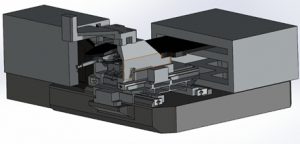Data-driven Parameters Tuning for Predictive Performance Improvement of Wirebonder Multi-body Model #SWI2023
The ASMPT Centre of Competency, located in Beuningen, is responsible for identifying new high-tech innovation opportunities for the full global ASMPT product portfolio. The equipment portfolio of ASMPT covers the complete back-end section of the semiconductor equipment market, and offers comprehensive assembly and advanced packaging solutions for its customers in the fields of optoelectronics, electronics, solar energy, automotive and other segments.

A wire bonder machine makes interconnections between an integrated circuit and its packaging during semiconductor device fabrication. This process puts high demands on machine dynamics, actuation system, and motion control. A digital twin of this machine is developed in a form of a multi-body dynamical model, such as to capture dynamical and control effects of the highest influence on throughput and accuracy of the wirebonding. However, it is still challenging to achieve the digital twin of high quantitative predictive performance in terms of accurate emulation of frequency- and time-domain measurements obtained from a physical machine.
The wirebonder model is not available in closed-form but is a numerical one implemented in Matlab toolbox Simscape Multibody. This model is an interconnection of multiple bodies, each having own inertial parameters (3 coordinates of the center of mass, 6 mass moments of inertia, mass). Their interconnections are lumped spring/damper elements with own stiffness and damping coefficients. On the machine we measure frequency characteristics or input/output relations between input forces and motions of the moving bodies. These frequency characteristics can also be simulated with the model.
The objective is to find parameters of the model that minimize differences between the measured and simulated frequency characteristics. No matter which numerical metrics of “similarity” between the measurements and simulations ASMPT does choose, that cost is nonconvex function of the model parameters. Here we talk about a set of 20-40 parameters that one needs to tune. This is a challenging program for ASMPT from a mathematical point of view.
A multi-body model of high predictive performance would be useful in many ways for ASMPT, such as:
- it would enable more accurate model-based controller design,
- would give better physical insights into role and contribution of the individual system onto overall machine performance,
- could be used for continuous machine condition monitoring and fault isolation.
